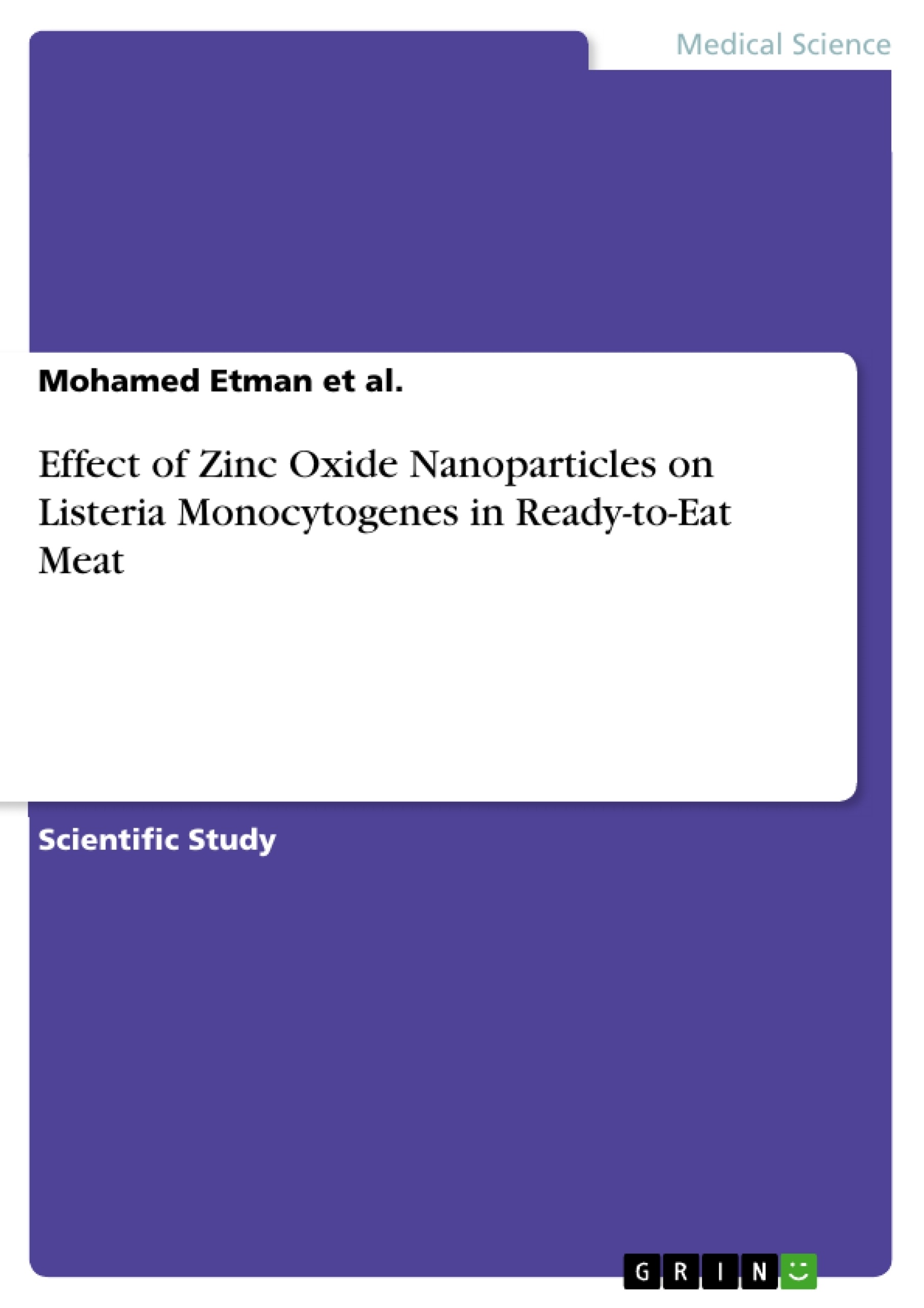The purpose of this study was investigation of the effect of zinc oxide nanoparticles (Zn O NPs) on Listeria monocytogenes in Ready-to-eat meat products, to introduce a new, cheap, safe and fast way of food preservation. This work was performed on 240 Random Samples of RTE meat products (Frankfurter, Salami, Basterma & Luncheon) ( 60 sample of each product ). There was a significant increase in Listeria monocytogenes CFU/g in the 1st control group of each product which was not treated by any concentration of Zn O NPs, while in the 2nd group of each product which was treated with 60 ppm of Zn O NPs, there was some inhibition of CFU/g , and in the 3rd group of each product which was treated with 90 ppm of Zn O NPs, there was a significant inhibition which is matching with the highest concentration of Zn O NPs used in this study .
Inhaltsverzeichnis (Table of Contents)
- Abstract
- Introduction
- Materials & methods
- Collection of samples (ISO-17604:2003)
- Apparatus and instruments: (ISO 7218:2007)
- Chemicals
- Listeria Reference Strain
- Selective primary enrichment medium (Half Fraser broth)(Oxoid )
- Agar Listeria according to Ottaviani Agosti (ALOA)
- Methods
- Synthesis of Nano-zinc Oxide via Sol-gel Technique
- Characterization of ZnO Nano powders
- X-ray Diffraction Analysis (XRD)
- Scanning Electron Microscopy (SEM)
- Enrichment of Listeria Reference (ISO 11290-2/A1-2004 )
- Preparation of samples( ISO 17604:2003)(ISO 11290-2/A1-2004 )
- Results & discussion
- Conclusion
Zielsetzung und Themenschwerpunkte (Objectives and Key Themes)
This study aimed to investigate the effect of zinc oxide nanoparticles (ZnONPs) on Listeria monocytogenes in Ready-to-eat (RTE) meat products. The objective was to introduce a new, cheap, safe, and fast method of food preservation. The study explored the antibacterial properties of ZnONPs in different concentrations and their impact on Listeria monocytogenes growth in RTE meat products.
- Antibacterial activity of zinc oxide nanoparticles (ZnONPs) against Listeria monocytogenes in RTE meat products
- The effectiveness of ZnONPs in inhibiting the growth of Listeria monocytogenes in various concentrations
- Exploring the potential of ZnONPs as a safe and effective food preservation method for RTE meat products
- Comparing the effectiveness of different ZnONPs concentrations against Listeria monocytogenes in RTE meat products
- Investigating the feasibility of using ZnONPs as a practical solution for reducing foodborne illness associated with Listeria monocytogenes contamination.
Zusammenfassung der Kapitel (Chapter Summaries)
The Introduction provides a comprehensive overview of the public health concern of foodborne illnesses, highlighting the severity of listeriosis caused by Listeria monocytogenes. The chapter discusses the prevalence of Listeria monocytogenes in various environments and its potential for causing severe infections in vulnerable populations. The section emphasizes the need for effective food preservation methods to combat the spread of this pathogen. The chapter also explores the antibacterial properties of zinc oxide nanoparticles and their potential as an antimicrobial agent. The Materials and Methods section outlines the detailed procedures used in the study. This includes the collection and preparation of RTE meat samples, the synthesis and characterization of ZnONPs, the inoculation of samples with Listeria monocytogenes, and the methodology for assessing the antibacterial efficacy of ZnONPs. The Results and Discussion section presents the findings of the study, analyzing the impact of different concentrations of ZnONPs on the growth of Listeria monocytogenes in various RTE meat products. The study concludes by evaluating the effectiveness of ZnONPs as a potential food preservative against Listeria monocytogenes.
Schlüsselwörter (Keywords)
This study focuses on the application of zinc oxide nanoparticles (ZnONPs) as a food preservative to inhibit the growth of Listeria monocytogenes in ready-to-eat meat products. The study aims to evaluate the antibacterial activity of ZnONPs against Listeria monocytogenes, explore its potential as a safe and effective food preservation method, and contribute to reducing foodborne illness caused by this pathogen.
- Quote paper
- Mohamed Etman et al. (Author), 2015, Effect of Zinc Oxide Nanoparticles on Listeria Monocytogenes in Ready-to-Eat Meat, Munich, GRIN Verlag, https://www.grin.com/document/298350



